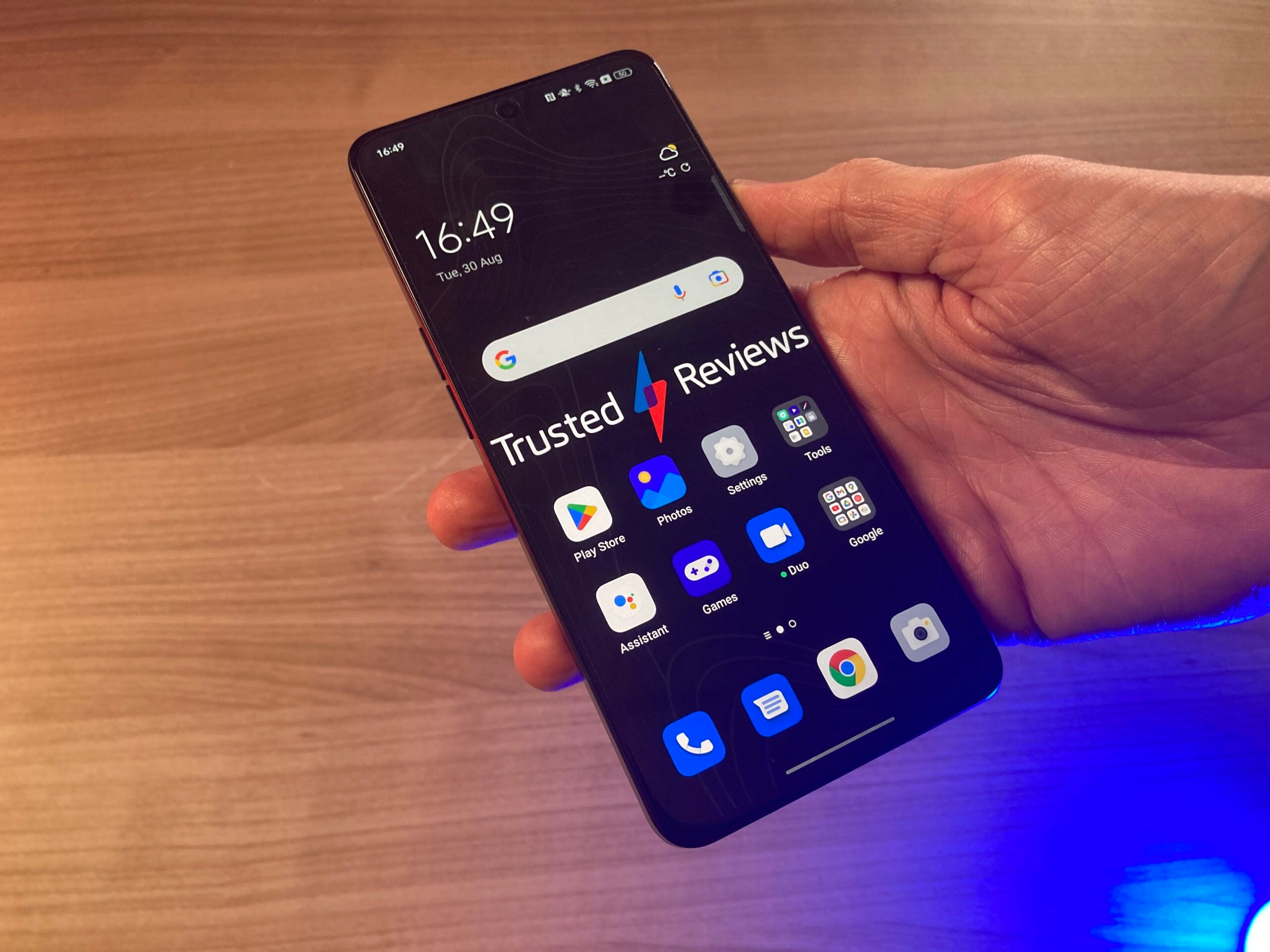Verdict
The Oppo Reno 8 Pro is a highly capable mid-range phone, with a particularly lush screen and a strong main camera. However, its design isn’t all that practical and the secondary cameras don’t measure up that well to the leading sensor.
Pros
- Great screen
- Strong main camera
- Speedy fast-charging
Cons
- Overly glossy rear panel
- Weaker secondary cameras
Availability
- UKRRP: £599
- USATBC
- EuropeTBC
- CanadaTBC
- AustraliaTBC
-
50-megapixel main cameraThe leading camera sensor of this handset has a high 50-megapixel resolution -
80W fast-chargingThis device is supported by 80W SuperVOOC wired fast-charging for when you need to top up the battery -
6.7-inch AMOLED screenThe Reno 8 Pro has a large display with a 120Hz maximum refresh rate and HDR10+ support
Introduction
Earlier this year, Oppo greatly impressed us with its Find X5 Pro, which delivered some of the very best photography that we’ve seen on an Android phone.
The Reno 8 Pro is not a direct sequel to that phone, despite some superficial resemblance. This is Oppo’s shot at a high-value mid-range phone, which packs a mix of flagship-level specs along with a few compromises here and there in order to maintain an appetising price point.
Some of the highlights of the phone include its 50-megapixel main camera, 80W charging, and a 6.7-inch AMOLED display. But do these bright spots outshine any potential pitfalls?
Design and Screen
- Smear-phone ultra-glossy finish
- Excellent screen
The design of the Oppo Reno 8 Pro is certainly unusual. For one thing, the Glazed Black colour is inherited from the Oppo Find X5 Pro, but unfortunately, that’s a con rather than a pro. This mirrorlike surface picks up even the whisper of a fingerprint, leaving the once-immaculate reflection smeared and spoiled. While it looks like a million dollars when you take it out of the box, by the time you’ve picked it up and used the device for ten minutes, it looks as grubby as the window of a phonebox (as you can see below):
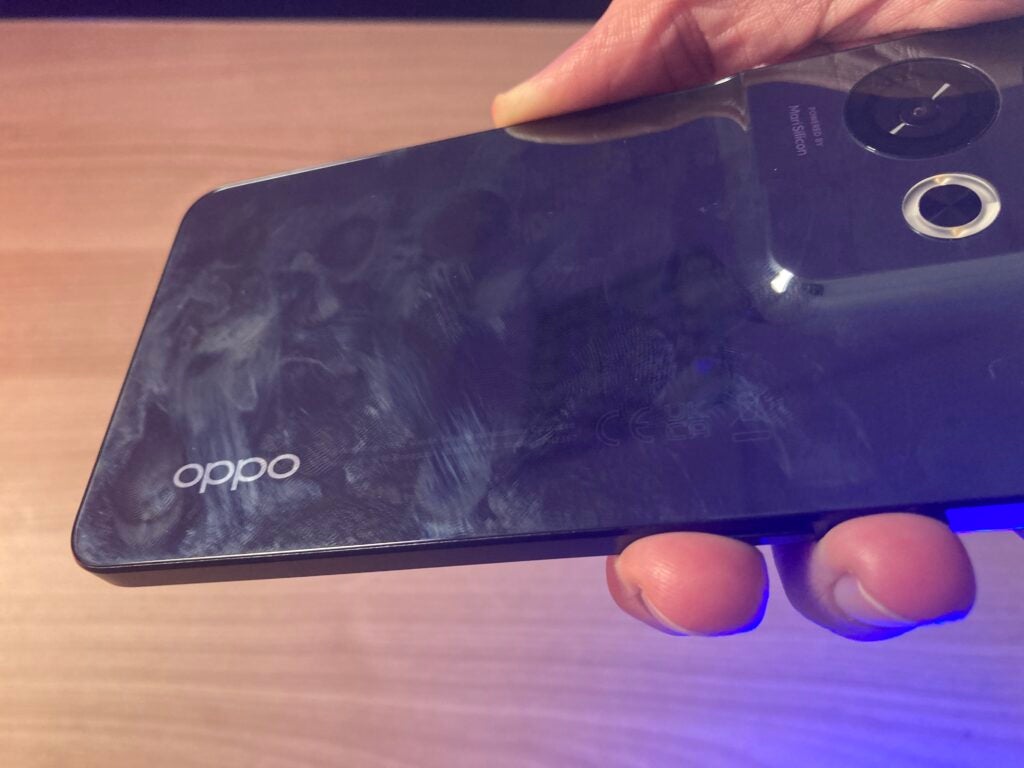
That’s a shame because there’s plenty else about the phone’s design that I actually really like.
While the camera module is indeed very large, it’s still smoothly incorporated into the rear panel in a subtle raised platform rather than being a distinct self-contained unit like other devices. To take an example, I personally prefer this approach to the jarring look on the likes of the OnePlus 10T, but I do just wish that it could have been paired with a more practical matte surface.
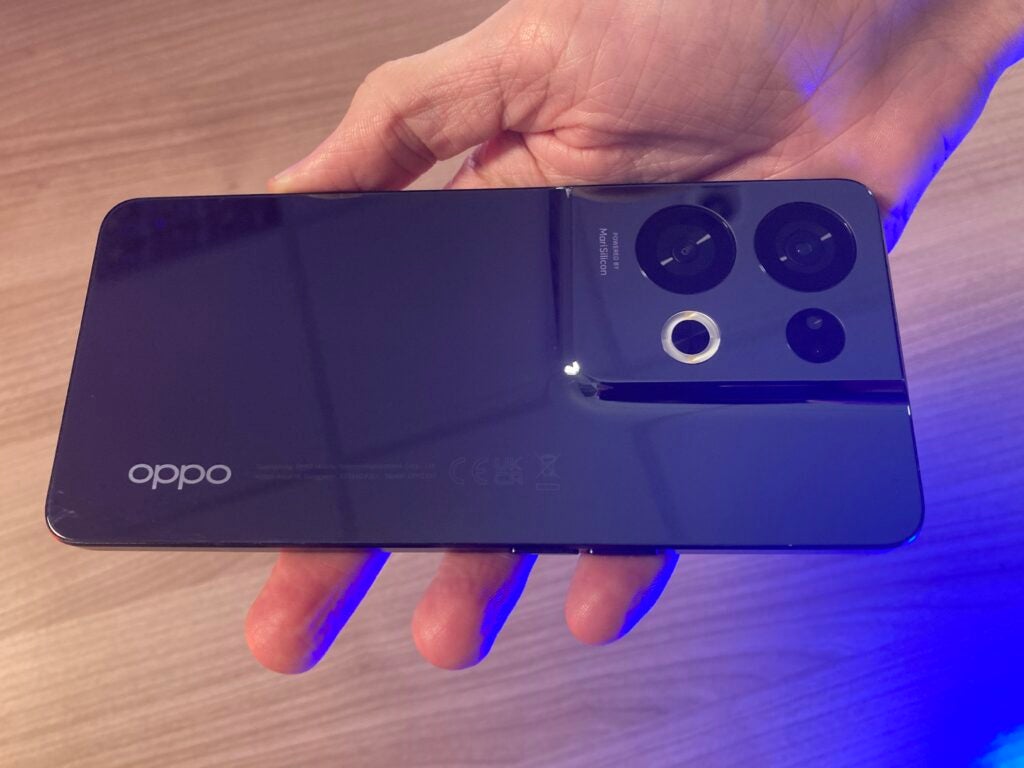
While the sides do feel like plastic (one of the price-point compromises you’ll find on the phone), I do like the fact that it has a flat screen rather than one that curves at the sides. With just a small punch-hole camera at the top and the thinnest bezels yet seen in the Oppo Reno series, it delivers a 93.4% screen-to-body ratio.
What’s more, the material on both the front and the back is Gorilla Glass 5, so it should be rather resistant to scratches and scuffs. On the other hand, there’s no IP rating here so we’re not to know what the damage might be if it were exposed to water or dust.
Despite the scale of the screen, this phone remains fairly easy to handle because it’s both relatively thin (at 7.34mm) and relatively lightweight too (at 183g), so it didn’t feel to onerous to manage with just one hand. What I will say for the rear panel is that it’s at least very comfortable to hold.
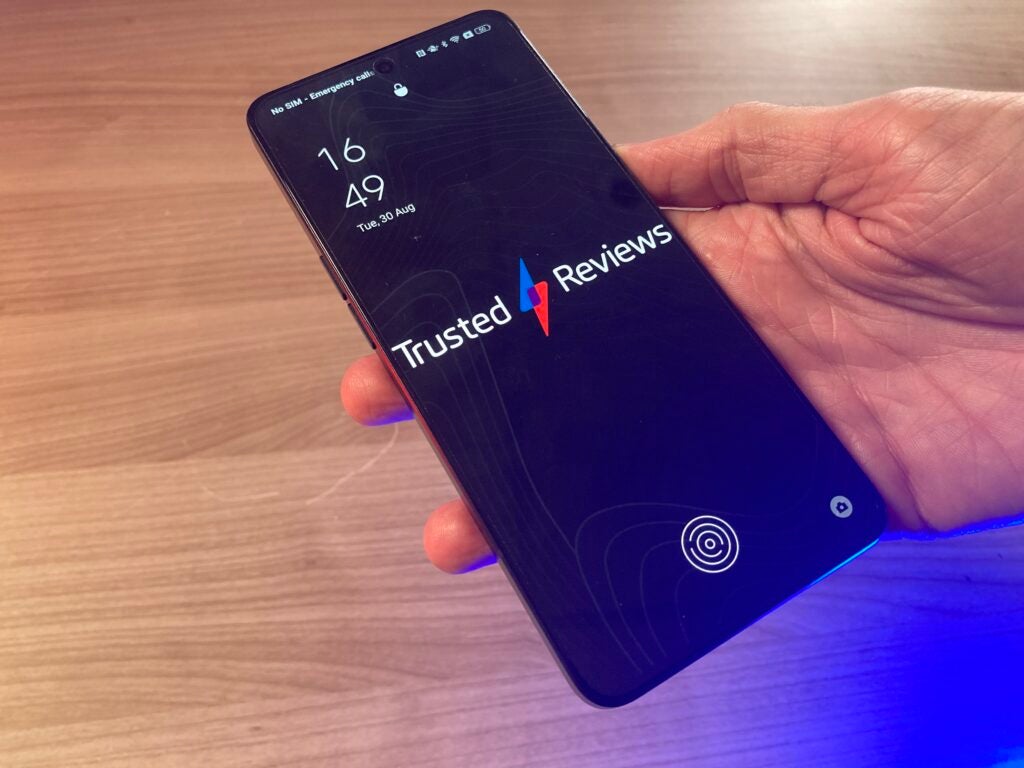
While there are elements of this design that will undoubtedly prove to be controversial amongst the customer base, I’m confident that the screen will find a much warmer reception.
The AMOLED panel naturally boasts excellent levels of contrast, and it measures a very healthy 6.7-inches, so it’s generous enough to feel pulled into what you’re watching or playing. The resolution is Full HD (2412x1080p), which is as high as you can hope for in the mid-range – and even among plenty of flagships for that matter – and it has a maximum refresh rate of 120Hz.
While this enhanced refresh rate does mean that compatible content runs very smoothly indeed, it does not automatically switch down to a lower refresh rate when you’re running a less demanding app; you have to change this manually in the Settings menu if you want to switch between 60Hz and 120Hz.
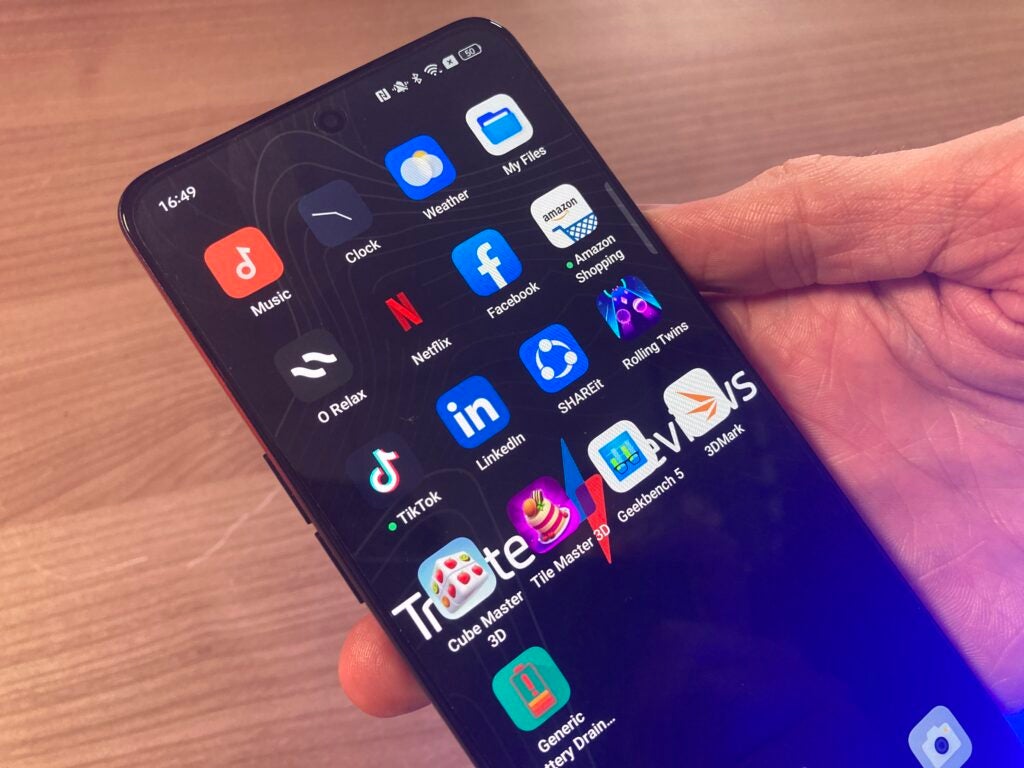
When you’re firing up videos on Netflix or Amazon Prime, you’ll be pleased to hear that there is HDR10+ support at play. It’s been specifically certified for both of these apps. This makes colours more punchy than they would be otherwise, and it really helps you enjoy content to another level. Watching TV shows really was a pleasure on this device, with the deep contrast pairing to perfection with the lively colours, and the size of the screen only adds to the enjoyment.
Camera
- Very pleasing results from the main camera
- Strong, if unnerving, night shooting capabilities
- Ultrawide is a step down, macro camera is poor
The Oppo Reno 8 Pro’s large and noticeable camera module houses three lenses and a flash. Among these, there’s a 50-megapixel main sensor, an 8-megapixel ultrawide lens with 112-degree field of view, and a 2-megapixel macro sensor. Due to its mid-range status, you’ll notice that there’s no telephoto sensor at play here for one thing, but how does it measure up otherwise?
Below are a few shots taken with the phone’s main camera:
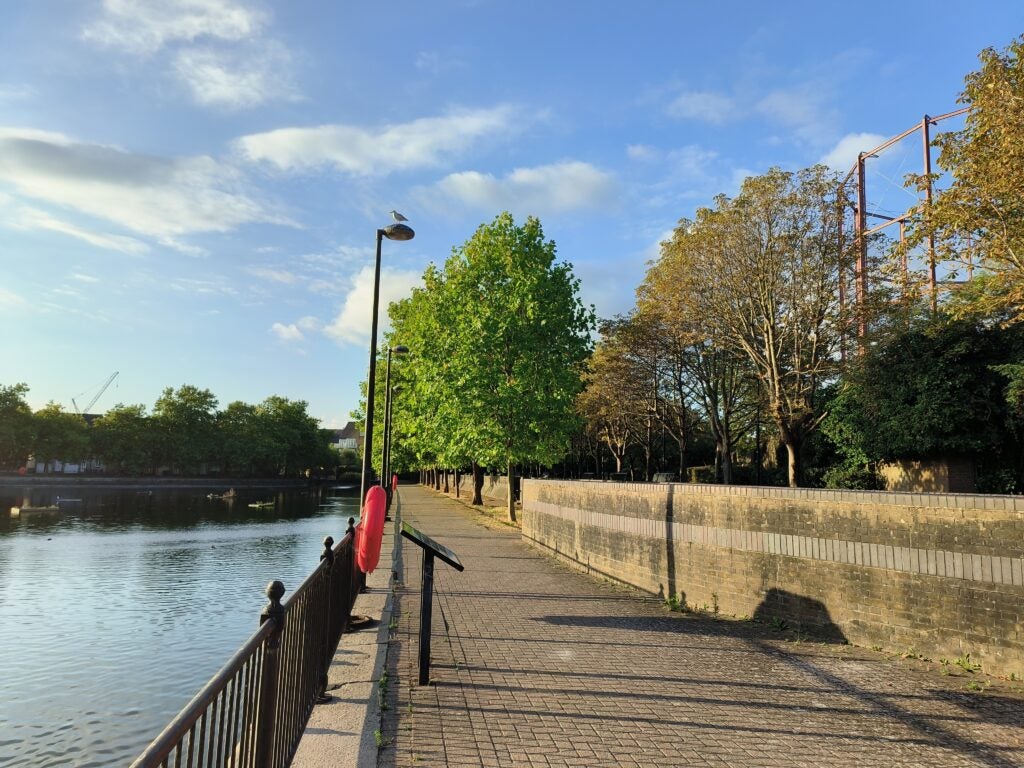


Generally, I found photos from the main camera to be bright and lively, packing in good amounts of detail and delivering pleasing pictures even in more difficult lighting conditions.
As aforementioned, there’s no telephoto lens on board – so you’ll have to make do with digital zoom. Unfortunately, I was underwhelmed by this function; the below shot was taken at 2x magnification, and there’s quite a significant loss of detail. If you like shooting close-ups, you’ll probably want to look for another smartphone with a dedicated zoom lens.

There is, however, an ultrawide lens, and whilst it is a stepdown in terms of resolution, it does still add an extra tool to your kit if you want to squeeze more into the frame of your photos. The images below were taken from the same position, first with the main camera and then with the ultrawide for direct comparison:


You’ll notice that the ultrawide image isn’t as sharp, and struggles a bit more with the lighting from the low sun in the early morning, so it’s not on a par with the main camera. However, it still can come in handy in certain scenarios when you want to take a step back from your subject.
The final of the three lenses in that raised camera module is a macro snapper. These are rarely very useful, and rather cynically I think they’re often just present to make up the numbers; but despite my low expectations, results were actually worse than I had feared. This little lens really isn’t worth your time (see below).

Night shooting is an aspect of this smartphone that has been particularly highlighted in the publicity materials, and with good reason. Just take a look at the picture below, which nicely balances the light and dark. It can take a second for the processing to complete, and results aren’t as good as you might see on Xiaomi 12 Pro for instance, but they are very appealing.

Sometimes, to paraphrase the football commentator Andy Townsend, Oppo’s approach to lowlight photography can almost work too well. The below picture was taken within two minutes of the one above, at 8pm, yet the sky has been so lightened that it’s hard to tell what the time of day really is.

Along with night shooting, the Reno 8 Pro also prides itself on the front-facing camera, which boasts a relatively large 32-megapixel resolution. Oppo claimed to me that it’s believed to be even better than the one on the Find X5 Pro, and I was certainly impressed with the results:

The detail is strong though the colours are quite cool, and the bokeh effect is well-realised (even despite my messy hair at the time of shooting). With selfies becoming more and more popular, this smartphone is a good choice if you like taking pictures of what’s in front of the camera as much as what’s behind it.
Performance
- Strong benchmark scores
- Great overall performance
A MediaTek Dimensity 8100-MAX is the muscle of this smartphone. Built on a 5nm process, it’s a capable chipset which is supported here by 8GB or 12GB of RAM, depending on which variant you choose to buy.
While you won’t quite get top-level flagship performance from this device, it still delivers more than enough heft for the vast majority of users. I never noticed any lag or slowdown when running basic tasks or multi-tasking with a few different apps, and even playing high-end games did not cause slowdown; in fact, the experience was a blast.
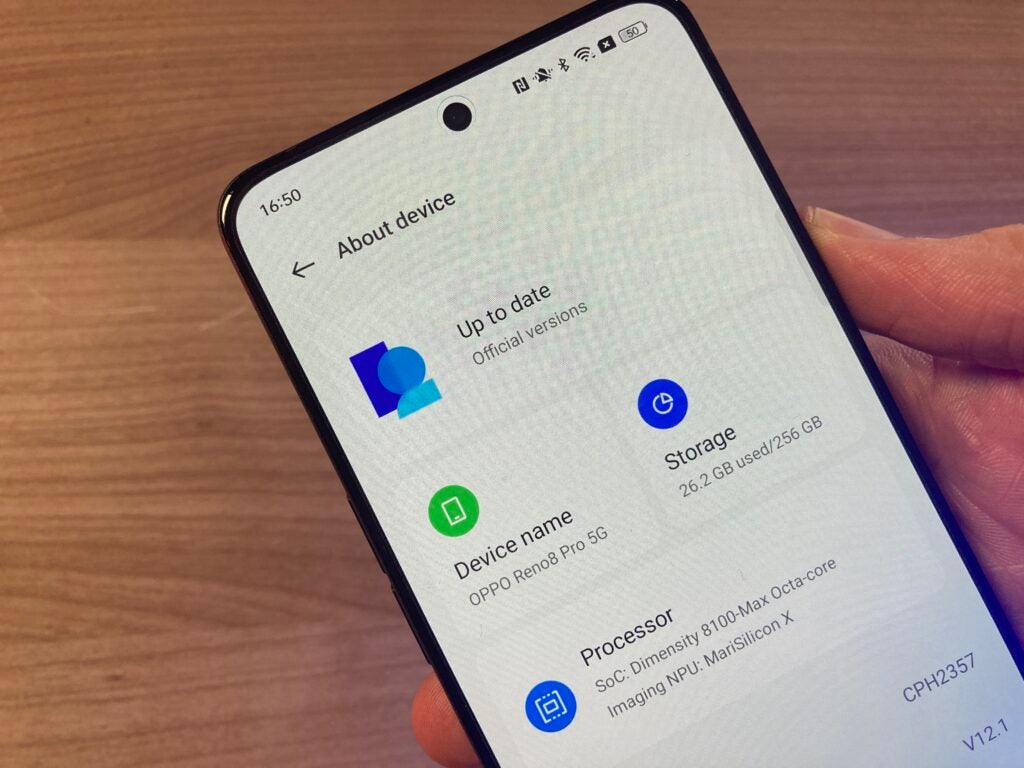
Below you can see some of the benchmarking scores for the handset, to see how it stacks up against other comparable devices. As you can see, it sticks with the rest of the pack but does not stand head and shoulders above many handsets judging by these metrics alone.
Oppo Reno 8 Pro: Benchmark Comparison
The software at play here is ColorOS 6.1, which is based on Android 12. While there are a few extra and unwanted apps present on start-up, including a handful of games, it’s not overloaded to the brim with bloatware unlike some of its peers (particularly those on Xiaomi’s MIUI).
This user interface also packs a quirky feature called Air Gestures which allows you to control video apps by moving your hands, but I found this a little temperamental in practice.
Battery Life
- Speedy fast-charging
- Good battery life
The Oppo Reno 8 Pro runs on a 4500mAh battery, which is a decent capacity that nonetheless falls just shy of the 5000mAh standard which tends to be the high watermark of Android phones these days.
In general, I found that it was a reliable battery that did get me through the day, though it wasn’t notably brilliant. To give a couple of concrete examples, it lost 5% charge after an hour of watching Netflix, which is a respectable score, but lost 9% charge after half an hour of intense mobile gaming, which is more rapid than most of its contemporaries.
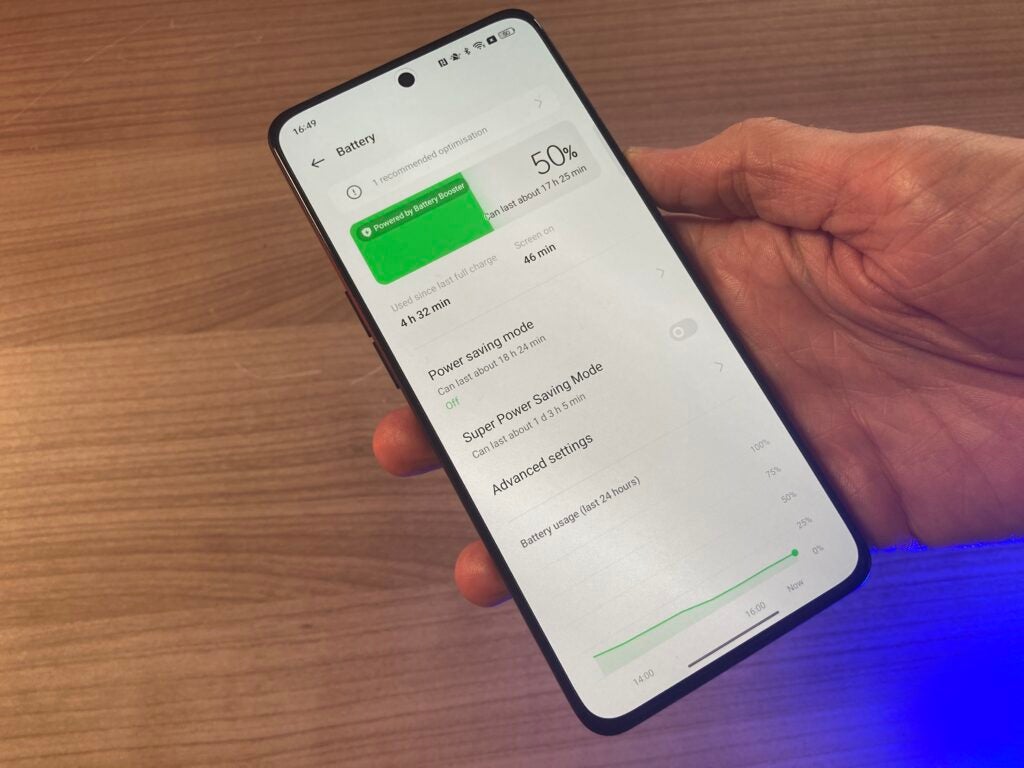
The 80W SuperVOOC fast-charging is a standout highlight of the device. When using the 80W-rated charger that’s supplied in the box, I timed it as reaching 50% of its battery after 16 minutes of charging, and it took a total of 45 minutes for it to go to 0-100%. While we have seen some better speeds than this before, with the OnePlus 10T being one such example, it still is a brilliant result and it does make quite some difference when you’re worried about your phone’s longevity and just need a quick top-up before hitting the road.
When charging figures such as these are mentioned, some users start to worry about both about the longevity and the health of their device. Oppo seeks to allay those concerns by pointing to its Battery Health Engine, which apparently ensures 1,600 charging cycles (around 4 years) of peak battery performance.
One potential downside of this phone is that there’s no wireless charging, though I find that to be a minor inconvenience; however, if you count on it to boost your phone through the day then you might feel its loss quite keenly here.
Latest deals
Should you buy it?
If you’re looking for a highly capable mid-ranger, then this one is likely to impress you across the board
The mirrorlike finish won’t stay pristine for long, and the secondary cameras aren’t at flagship standard
Final Thoughts
There’s plenty to like about the Oppo Reno 8 Pro, especially given its silky screen, strong main camera, durable battery life and its capable performance. However, there are still a few flaws here, one of the key ones being its impractically glossy rear panel which picks up fingerprints as if by magnetism. On top of that, the secondary cameras aren’t quite up to the same mark as the main one.
However if you’re on the hunt for a good all-round mid-ranger you want to use to watch content and shoot some snaps through the day, then this is a very good choice for the pricetag.
How we test
We test every mobile phone we review thoroughly. We use industry standard tests to compare features properly and we use the phone as our main device over the review period. We’ll always tell you what we find and we never, ever, accept money to review a product.
Used as our main handset during test period
Camera tested in variety of situations with all modes
Tested with synthetic benchmarks and real world use
FAQs
Yes, you can get 5G speeds as long as you have a compatible SIM card and network coverage
No, there’s no stated IP rating so we’re not to know exactly how it could deal with exposure to water or dust
It’s available in Glazed Black (as reviewed above) and Glazed Green colour schemes
Trusted Reviews test data
Sustainability
TrustedReviews’ holds the fact that global warming is not a myth as a core value and will continuously endeavor to help protect our planet from harm in its business practices.
As part of this mission, whenever we review a product we send the company a series of questions to help us gauge and make transparent the impact the device has on the environment.
We currently haven’t received answers to the questions on this product, but will update this page the moment we do. You can see a detailed breakdown of the questions we ask and why in our sustainability info page.
Jargon buster
IP rating
An abbreviation for ‘Ingress Protection Code’, which lets you know to what extent a device might be waterproof or dustproof.
OLED and AMOLED
Types of displays that use self-lighting pixels to provide greater contrast and more vibrant colours than a typical LCD display, as well as sharper blacks.
Verdict
The Oppo Reno 8 Pro is a highly capable mid-range phone, with a particularly lush screen and a strong main camera. However, its design isn’t all that practical and the secondary cameras don’t measure up that well to the leading sensor.
Pros
- Great screen
- Strong main camera
- Speedy fast-charging
Cons
- Overly glossy rear panel
- Weaker secondary cameras
Availability
- UKRRP: £599
- USATBC
- EuropeTBC
- CanadaTBC
- AustraliaTBC
-
50-megapixel main cameraThe leading camera sensor of this handset has a high 50-megapixel resolution -
80W fast-chargingThis device is supported by 80W SuperVOOC wired fast-charging for when you need to top up the battery -
6.7-inch AMOLED screenThe Reno 8 Pro has a large display with a 120Hz maximum refresh rate and HDR10+ support
Introduction
Earlier this year, Oppo greatly impressed us with its Find X5 Pro, which delivered some of the very best photography that we’ve seen on an Android phone.
The Reno 8 Pro is not a direct sequel to that phone, despite some superficial resemblance. This is Oppo’s shot at a high-value mid-range phone, which packs a mix of flagship-level specs along with a few compromises here and there in order to maintain an appetising price point.
Some of the highlights of the phone include its 50-megapixel main camera, 80W charging, and a 6.7-inch AMOLED display. But do these bright spots outshine any potential pitfalls?
Design and Screen
- Smear-phone ultra-glossy finish
- Excellent screen
The design of the Oppo Reno 8 Pro is certainly unusual. For one thing, the Glazed Black colour is inherited from the Oppo Find X5 Pro, but unfortunately, that’s a con rather than a pro. This mirrorlike surface picks up even the whisper of a fingerprint, leaving the once-immaculate reflection smeared and spoiled. While it looks like a million dollars when you take it out of the box, by the time you’ve picked it up and used the device for ten minutes, it looks as grubby as the window of a phonebox (as you can see below):

That’s a shame because there’s plenty else about the phone’s design that I actually really like.
While the camera module is indeed very large, it’s still smoothly incorporated into the rear panel in a subtle raised platform rather than being a distinct self-contained unit like other devices. To take an example, I personally prefer this approach to the jarring look on the likes of the OnePlus 10T, but I do just wish that it could have been paired with a more practical matte surface.

While the sides do feel like plastic (one of the price-point compromises you’ll find on the phone), I do like the fact that it has a flat screen rather than one that curves at the sides. With just a small punch-hole camera at the top and the thinnest bezels yet seen in the Oppo Reno series, it delivers a 93.4% screen-to-body ratio.
What’s more, the material on both the front and the back is Gorilla Glass 5, so it should be rather resistant to scratches and scuffs. On the other hand, there’s no IP rating here so we’re not to know what the damage might be if it were exposed to water or dust.
Despite the scale of the screen, this phone remains fairly easy to handle because it’s both relatively thin (at 7.34mm) and relatively lightweight too (at 183g), so it didn’t feel to onerous to manage with just one hand. What I will say for the rear panel is that it’s at least very comfortable to hold.

While there are elements of this design that will undoubtedly prove to be controversial amongst the customer base, I’m confident that the screen will find a much warmer reception.
The AMOLED panel naturally boasts excellent levels of contrast, and it measures a very healthy 6.7-inches, so it’s generous enough to feel pulled into what you’re watching or playing. The resolution is Full HD (2412x1080p), which is as high as you can hope for in the mid-range – and even among plenty of flagships for that matter – and it has a maximum refresh rate of 120Hz.
While this enhanced refresh rate does mean that compatible content runs very smoothly indeed, it does not automatically switch down to a lower refresh rate when you’re running a less demanding app; you have to change this manually in the Settings menu if you want to switch between 60Hz and 120Hz.

When you’re firing up videos on Netflix or Amazon Prime, you’ll be pleased to hear that there is HDR10+ support at play. It’s been specifically certified for both of these apps. This makes colours more punchy than they would be otherwise, and it really helps you enjoy content to another level. Watching TV shows really was a pleasure on this device, with the deep contrast pairing to perfection with the lively colours, and the size of the screen only adds to the enjoyment.
Camera
- Very pleasing results from the main camera
- Strong, if unnerving, night shooting capabilities
- Ultrawide is a step down, macro camera is poor
The Oppo Reno 8 Pro’s large and noticeable camera module houses three lenses and a flash. Among these, there’s a 50-megapixel main sensor, an 8-megapixel ultrawide lens with 112-degree field of view, and a 2-megapixel macro sensor. Due to its mid-range status, you’ll notice that there’s no telephoto sensor at play here for one thing, but how does it measure up otherwise?
Below are a few shots taken with the phone’s main camera:



Generally, I found photos from the main camera to be bright and lively, packing in good amounts of detail and delivering pleasing pictures even in more difficult lighting conditions.
As aforementioned, there’s no telephoto lens on board – so you’ll have to make do with digital zoom. Unfortunately, I was underwhelmed by this function; the below shot was taken at 2x magnification, and there’s quite a significant loss of detail. If you like shooting close-ups, you’ll probably want to look for another smartphone with a dedicated zoom lens.

There is, however, an ultrawide lens, and whilst it is a stepdown in terms of resolution, it does still add an extra tool to your kit if you want to squeeze more into the frame of your photos. The images below were taken from the same position, first with the main camera and then with the ultrawide for direct comparison:


You’ll notice that the ultrawide image isn’t as sharp, and struggles a bit more with the lighting from the low sun in the early morning, so it’s not on a par with the main camera. However, it still can come in handy in certain scenarios when you want to take a step back from your subject.
The final of the three lenses in that raised camera module is a macro snapper. These are rarely very useful, and rather cynically I think they’re often just present to make up the numbers; but despite my low expectations, results were actually worse than I had feared. This little lens really isn’t worth your time (see below).

Night shooting is an aspect of this smartphone that has been particularly highlighted in the publicity materials, and with good reason. Just take a look at the picture below, which nicely balances the light and dark. It can take a second for the processing to complete, and results aren’t as good as you might see on Xiaomi 12 Pro for instance, but they are very appealing.

Sometimes, to paraphrase the football commentator Andy Townsend, Oppo’s approach to lowlight photography can almost work too well. The below picture was taken within two minutes of the one above, at 8pm, yet the sky has been so lightened that it’s hard to tell what the time of day really is.

Along with night shooting, the Reno 8 Pro also prides itself on the front-facing camera, which boasts a relatively large 32-megapixel resolution. Oppo claimed to me that it’s believed to be even better than the one on the Find X5 Pro, and I was certainly impressed with the results:

The detail is strong though the colours are quite cool, and the bokeh effect is well-realised (even despite my messy hair at the time of shooting). With selfies becoming more and more popular, this smartphone is a good choice if you like taking pictures of what’s in front of the camera as much as what’s behind it.
Performance
- Strong benchmark scores
- Great overall performance
A MediaTek Dimensity 8100-MAX is the muscle of this smartphone. Built on a 5nm process, it’s a capable chipset which is supported here by 8GB or 12GB of RAM, depending on which variant you choose to buy.
While you won’t quite get top-level flagship performance from this device, it still delivers more than enough heft for the vast majority of users. I never noticed any lag or slowdown when running basic tasks or multi-tasking with a few different apps, and even playing high-end games did not cause slowdown; in fact, the experience was a blast.

Below you can see some of the benchmarking scores for the handset, to see how it stacks up against other comparable devices. As you can see, it sticks with the rest of the pack but does not stand head and shoulders above many handsets judging by these metrics alone.
Oppo Reno 8 Pro: Benchmark Comparison
The software at play here is ColorOS 6.1, which is based on Android 12. While there are a few extra and unwanted apps present on start-up, including a handful of games, it’s not overloaded to the brim with bloatware unlike some of its peers (particularly those on Xiaomi’s MIUI).
This user interface also packs a quirky feature called Air Gestures which allows you to control video apps by moving your hands, but I found this a little temperamental in practice.
Battery Life
- Speedy fast-charging
- Good battery life
The Oppo Reno 8 Pro runs on a 4500mAh battery, which is a decent capacity that nonetheless falls just shy of the 5000mAh standard which tends to be the high watermark of Android phones these days.
In general, I found that it was a reliable battery that did get me through the day, though it wasn’t notably brilliant. To give a couple of concrete examples, it lost 5% charge after an hour of watching Netflix, which is a respectable score, but lost 9% charge after half an hour of intense mobile gaming, which is more rapid than most of its contemporaries.

The 80W SuperVOOC fast-charging is a standout highlight of the device. When using the 80W-rated charger that’s supplied in the box, I timed it as reaching 50% of its battery after 16 minutes of charging, and it took a total of 45 minutes for it to go to 0-100%. While we have seen some better speeds than this before, with the OnePlus 10T being one such example, it still is a brilliant result and it does make quite some difference when you’re worried about your phone’s longevity and just need a quick top-up before hitting the road.
When charging figures such as these are mentioned, some users start to worry about both about the longevity and the health of their device. Oppo seeks to allay those concerns by pointing to its Battery Health Engine, which apparently ensures 1,600 charging cycles (around 4 years) of peak battery performance.
One potential downside of this phone is that there’s no wireless charging, though I find that to be a minor inconvenience; however, if you count on it to boost your phone through the day then you might feel its loss quite keenly here.
Latest deals
Should you buy it?
If you’re looking for a highly capable mid-ranger, then this one is likely to impress you across the board
The mirrorlike finish won’t stay pristine for long, and the secondary cameras aren’t at flagship standard
Final Thoughts
There’s plenty to like about the Oppo Reno 8 Pro, especially given its silky screen, strong main camera, durable battery life and its capable performance. However, there are still a few flaws here, one of the key ones being its impractically glossy rear panel which picks up fingerprints as if by magnetism. On top of that, the secondary cameras aren’t quite up to the same mark as the main one.
However if you’re on the hunt for a good all-round mid-ranger you want to use to watch content and shoot some snaps through the day, then this is a very good choice for the pricetag.
How we test
We test every mobile phone we review thoroughly. We use industry standard tests to compare features properly and we use the phone as our main device over the review period. We’ll always tell you what we find and we never, ever, accept money to review a product.
Used as our main handset during test period
Camera tested in variety of situations with all modes
Tested with synthetic benchmarks and real world use
FAQs
Yes, you can get 5G speeds as long as you have a compatible SIM card and network coverage
No, there’s no stated IP rating so we’re not to know exactly how it could deal with exposure to water or dust
It’s available in Glazed Black (as reviewed above) and Glazed Green colour schemes
Trusted Reviews test data
Sustainability
TrustedReviews’ holds the fact that global warming is not a myth as a core value and will continuously endeavor to help protect our planet from harm in its business practices.
As part of this mission, whenever we review a product we send the company a series of questions to help us gauge and make transparent the impact the device has on the environment.
We currently haven’t received answers to the questions on this product, but will update this page the moment we do. You can see a detailed breakdown of the questions we ask and why in our sustainability info page.
Jargon buster
IP rating
An abbreviation for ‘Ingress Protection Code’, which lets you know to what extent a device might be waterproof or dustproof.
OLED and AMOLED
Types of displays that use self-lighting pixels to provide greater contrast and more vibrant colours than a typical LCD display, as well as sharper blacks.


















